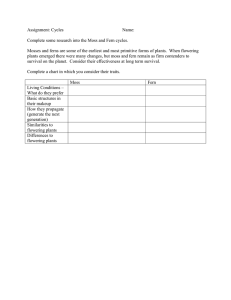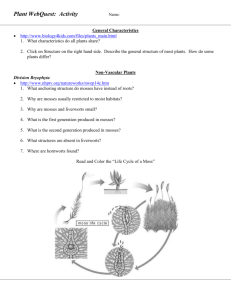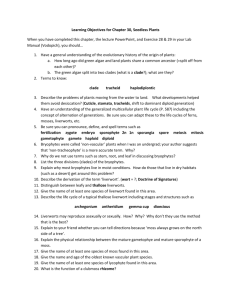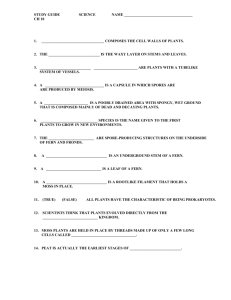Document 12969077
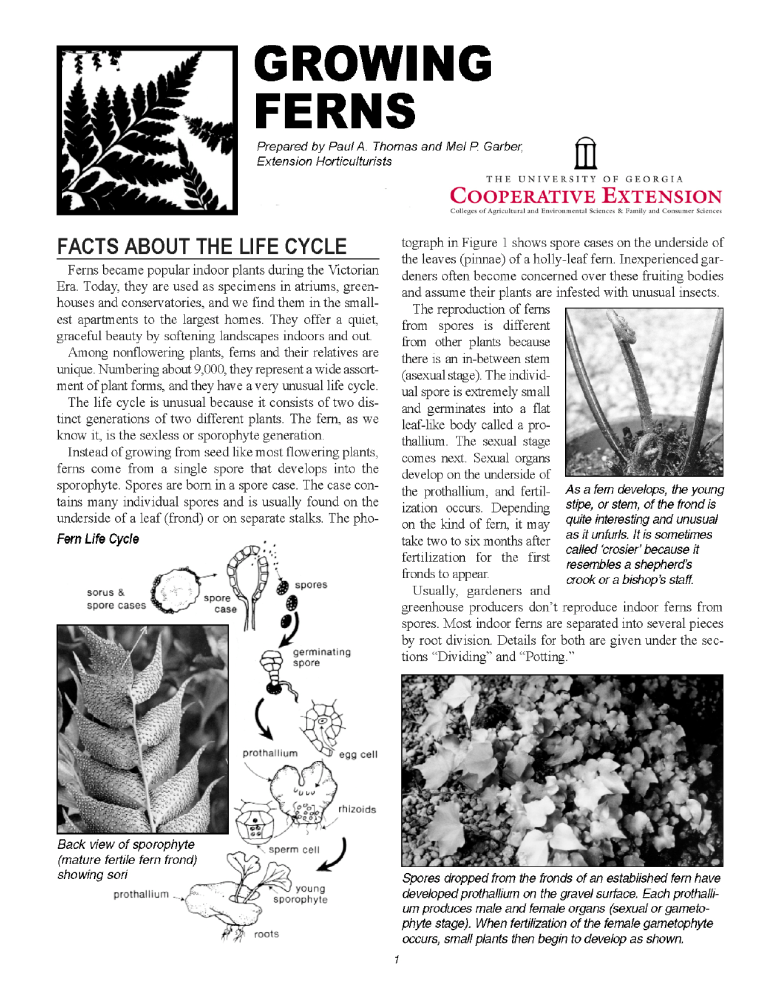
This is an established holly fern. It grows best in warmer areas of Georgia but often survives in protected locations in colder parts of the state.
TEMPERATURE
Even though most ferns used for indoor culture are native to the tropics or subtropics, they for the most part prefer a cool temperature and a high level of moisture in the air
(humidity). In the woodlands or tropics, ferns are found under rather dense canopies of trees or large woody plants.
Some species are native to rather dry climates that have periods of heavy rainfall. Usually these periods of rainfall occur during hot weather, thus providing a cooling effect.
Room temperatures that are comfortable for human beings are usually a bit warm for many ferns. Nighttime temperatures for ferns should be on the cool side, preferably below 60°F. Daytime temperatures should not be above 72° and preferably cooler.
When ferns are grown outdoors during summer, they should be located in the cooler areas of the garden, usually in deep shade or on the north side of the house or a garden structure. Never expose ferns to full sun in summer.
Leatherleaf ferns don’t like normal household temperatures. They grow best in temperatures under 75°F.
2
HUMIDITY
Growing ferns inside your home is a real challenge.
Culture today is not as easy as it was in earlier years. The increased difficulty stems partly from the changes in our lifestyles. As we have become more affluent, fern culture has become more difficult. Before the widespread use of forced air or steam heat, there was usually a cool room where the humidity was a bit higher. Forced air and steam heat tend to dry the air and reduce the humidity below the point where ferns can survive. A humidity level of 30 percent is about as low as most ferns will tolerate. Forty to 50 percent is certainly a more desirable range.
There are several ways to overcome dry air. You can add humidifiers to your home heating system or buy a selfcontained electric humidifier. A humidifier will produce not only better environmental conditions for your ferns and other house plants but also a healthier atmosphere for you and your family.
If you don’t want to purchase a humidifier, put pots of ferns or other plants in saucers or trays filled with gravel and water. This increases humidity around the plant.
Always maintain the water level just below the surface of the gravel so the bottom of the pot won’t be standing in water. Some indoor gardeners add charcoal chips to the gravel. This helps keep the water clean and odor free. For best results, replace the gravel periodically or wash it thoroughly at three-month intervals or as algae, etc., start to develop in the water or on the gravel. Sanitation is important in keeping down diseases.
When you grow ferns in decorative tubs, ceramic or cache pots without drainage holes, put an inch of gravel in the bottom of the container. A better approach is to plant the fern in a clay pot and set inside the decorative container. Then put sphagnum moss in the space between the two containers. Keep the moss moist. This helps increase humidity and prevents rapid drying of the soil.
During winter when your heat is on, many ferns need misting. Use an atomizer, plant mister or a plastic spray bottle that gives off a fine mist. Mist the plants early in the morning. Apply enough to moisten the fronds. Ruffled or fluffy (finely textured with dense foliage) ferns are a bit sensitive to too much water on their foliage. Mist these types only when your air is extremely dry. Broader- and thicker-leaved ferns may need daily misting when your heat is on frequently or for long periods.
Humidity is one of the most limiting factors in fern culture. Without a fairly high level of air moisture, most ferns will be unattractive and unhealthy.
LIGHT
There is a fern suited to almost any condition found in the average home. For example, holly ferns ( Cyrtomium falcatum ) grow in low to medium light, while birds nest ferns
( Asplenium nidus ) grow in low to bright, but not direct,
sun. A northern window usually provides ideal light conditions for many types of ferns. You can use a sheer curtain or drape to cut intensity. During summer months, you need to reduce light in eastern or western windows by about 50 percent. Asparagus ferns, which are not ferns but belong to the lily family, require bright light year-round and thrive in direct sunlight. Check the cultural chart for the specific light requirements of several different types of ferns.
POTTING
Ideally, an attractive and healthy fern will have just enough room to accommodate the root system with about an inch of space for further growth. Most ferns develop shallow root systems, so shallow pots or pans are best. To maintain the proper balance of root systems and space, some ferns, depending on growth rate, need repotting several times a year.
This asparagus fern needs dividing or transplanting to a larger pot. The root system has exerted enough pressure to crack the pot. For best results, don’t wait this long to divide or transplant ferns.
When you pot, remember that a small fern in a large container looks rather ridiculous and will be more subject to problems because of moisture excesses, etc. Start small ferns in small pots. Shift them to the next size pots as they become crowded.
Inexperienced gardeners repot ferns just as the pots seem to be three-fourths full. However, you should wait until the plant seems to be spilling out of the pot before repotting. Remember that some ferns grow rapidly, while others are extremely slow. In time, you will learn the growth characteristics of the ferns you enjoy.
Years ago, clay pots, wooden boxes or moss baskets were the most popular fern containers. Today, however, many gardeners use plastic pots. Growing plants in plastic pots is a bit different than other containers because moisture and air cannot move through plastic. This means you have to water the plants less often.
3
Regardless of the pot you use, you will be more successful if the containers have drainage holes. In potting, place an inch of gravel or clean pieces of broken pots in the bottom of your container. This keeps the drainage holes from clogging. Also, make certain the pots are thoroughly clean. If you’ve used the pots for other plants, you should scrub them thoroughly with a strong detergent and hot water. It’s also a good idea to soak the pots in a solution of one part household bleach and nine parts water.
This eliminates disease problems. In mixing and handling the bleach solution, exercise caution. You may injure your skin and eyes if you handle the solution improperly. When using new clay pots, soak them in clean water overnight, preferably longer. This rinses away any chemicals and thoroughly moistens the pot. Periodic washing of the pots is desirable too. This helps remove scum, soil, accumulated fertilizer salts or other materials that might clog air spaces in clay pots.
Potting new plants is relatively simple. After you clean old pots or soak new ones, put gravel or broken crockery in the bottom. Then, partially fill the pot with your potting soil or mixture. Do not pack the soil. Pull the root ball apart so you can spread the roots outward to the edges of the pot. This space facilitates watering. Gently firm the soil if necessary but be careful not to cover the crown of the plant. Water thoroughly to moisten all the soil.
If you’re repotting old or pot-bound plants, thoroughly water them to make them easier to remove. Do not try to pull the fern from the pot. Instead, put your fingers between the fronds at the base of the plant. Invert the pot, then tap the rim on a table or hard surface. The plant should come out easily after several firm taps. Shift it to the next pot or divide it.
DIVIDING FERNS
Often times, ferns such as Boston and sword outgrow their pots; then you have to divide or discard them. When it comes to dividing, ferns can take rather harsh treatment.
In some cases, you may have to use considerable force to remove the plant from the pot. Once it’s free, use a sharp, long-bladed knife to halve or quarter the root ball. Then, pull each quarter or half apart so you can spread the roots in the new soil. The main requirements after dividing are to water the roots and new soil thoroughly and to provide a humid atmosphere by misting the first few weeks.
GROWING MEDIUM
(POTTED PLANTS)
Growing mediums vary considerably for the many types of indoor ferns. However, all good mixtures have several things in common. They are well drained because of different components like coarse sand, gravel and charcoal.
Most mixtures contain considerable organic matter like
peat moss, peat humus, leaf mold, ground sphagnum moss and manure. A soil mixture for ferns must hold adequate but not excessive moisture, contain organic matter and be well aerated so air can move through the soil.
The proportion of the materials varies from one mixture to another depending on the fern. Some gardeners prefer rotted leaf mold. It is most like one of the main ingredients of the soils where many ferns naturally grow. Peat moss and ground or shredded sphagnum moss are more widely used because they are easy to obtain. Artificial mixes used by commercial plant growers are available to the gardening public now and are excellent for ferns.
Regardless of the mixture you use, be sure it is thoroughly mixed. Damp ingredients are easier to mix and pot.
They are also safer for the plants.
A typical mixture contains equal parts of peat moss, sand and garden soil. Add lime (one teaspoon per quart of mixture) for the types of common ferns. Other ferns, like maidenhair, thrive in a mixture of one-half peat moss, onefourth garden or potting soil, and one-fourth of a mixture of equal parts sand, charcoal chips and manure. Usually, for maidenhair, a tablespoon of ground limestone is added per gallon of mixture.
Other mixtures might have ingredients like manure and charcoal. Both are good additions to any mixture. Manure provides nutrition, and charcoal improves drainage. Check the cultural chart for specific mixtures for different types of ferns. If you use a mix with charcoal, you might try chips from aquarium supply stores.
WATERING
Supplying moisture is very complex. This is due to variations in the needs of the plant, its size, the soil mixture and the environment (temperature and light) in which the plant grows. Ferns are certainly no exception. However, for a wide range of them, you can expect to water fairly heavily, particularly during the growing season. This may mean watering daily or once a week. There are no hard and fast rules. To know when to water ferns and all other plants, you must develop a sense of feel of the soil. This is the only way to determine when to water.
Some gardeners water by soaking ferns in clay pots in a sink or tub of water for a few minutes. If you do this, remove the plants as soon as they are soaked, usually when the bubbling stops. Don’t submerge the plant when you soak it. Some ferns are sensitive to being covered with water, even for a few minutes. Also, fronds of some types are very brittle, while others are extremely soft. The weight of excess water may break or damage them.
Your watering practices determine your success with ferns. Over or under watering are by far the most common reasons for poor results. Shedding or leaflets occurs very rapidly if the plants are under or over watered.
Sprengeri fern, along with the true ferns, needs grooming periodically to remove dead stems and dropped leaves.
GROOMING
Ferns need grooming periodically to help them maintain health and vigor. This simply means removing dead fronds or matings of dropped leaflets. This is particularly important in the fluffy types that may be quite compact. Keep the pot clean. Wash it occasionally with warm water and a soft brush.
4
This ‘curly’ fern is a selection of Boston that does not grow as large but is noted for its lacy appearance. Note the fronds that have reverted back to Boston. These should be pruned out to maintain the curly look.
PEST PROBLEMS
Ferns have relatively few pest problems. However, when they do occur, they can be devastating. The major pests of ferns include fern scale, hemispherical scale and several species of mealy bugs.
Scales are usually hard-bodied insects without visible legs or means of movement. They may be white or brown, depending upon the insect. Mealy bugs are soft and appear
to be covered with a white, mealy or downy substance.
The presence of honeydew, a sticky syruplike material on the foliage, is an indication of fern scales or other insects.
If the insects continue to excrete the honeydew, black moldlike algae or fungus develops and gives the entire fern a blackened appearance.
When you purchase plants, inspect them carefully to make certain they are free of insects. Check the tops and bottoms of the leaflets and the stems. Do not buy any plants showing the slightest sign of insects.
For years, ferns were considered extremely sensitive to most common insecticides. Consequently, a general recommendation was to discard plants infested with insects.
Research in recent years indicates that many ferns are tolerant to some of our insecticides with only slight injury resulting. However, few, if any, pesticides are cleared by governmental agencies for use on ferns.
Scale insects are the most serious pest of ferns. The
Boston fern illustrates unthriftness and shedding of leaflets (pinnae). Infested plants yellow, shed leaflets and gradually die.
A close-up of leaflets (pinnae) and stem (stipe) shows the clustering of the scale insect.
5
LANDSCAPE PLANTINGS
The basics of growing ferns in the landscape are the same as growing them in pots. Site selection in terms of drainage and light exposure is critical to production of high-quality ferns.
Ferns require well-drained soil. Sandy soils or humus soils with good surface drainage are preferred. Heavy clay soils or soils with a shallow clay pan should be avoided or amended to provide good aeration and drainage. Elevated beds with amended media are excellent sites in the landscape because they ensure good aeration under most conditions.
Light intensity is another key factor in site selection for plantings of ferns. Ferns either prefer or require indirect light for production of high-quality fronds
(leaves). They are excellent plants for shady areas where other plants will not grow well. Avoid direct exposure to afternoon sun.
Outdoor planted ferns can be divided by separating clump or cutting off established runners. The best time for dividing outdoor ferns is after the first frost through November. This gives the transplants plenty of time to regenerate roots. No fertilizer is needed for fall transplants.
TERMINOLOGY
The following terminology is used by fern specialists, botanical and/or fern societies:
• Blade - main part of a frond; generally stipes plus blade make up the frond.
• Caudex - stem or stalk of the fern plant
• Fertile leaf - a leaf that bears spore cases or
“fruit dots”
• Frond - the leaf of a fern
• Fruit band - on some ferns, a line of spore cases occurring on the leaf margin or underside of the leaf
• Leaflets - one of the divisions of a compound leaf
• Midvein - the central and most prominent vein of a pinnae
• Pinnae - leaflets that are arranged along the blade
• Rachis - a continuation of the stipe that extends from the base of the plant to its apex
• Rhizome - stems, above or below ground (usually below ground), producing fronds above and roots below
• Sori - spore cases on ferns
• Sorus - spore case of ferns
• Stipe - stem or stalk of a frond
NATIVE FERN SPECIES
Adapted from Connie P. Gray 1/92
Botanical Name
A. Ferns of the Piedmont
Adiatum pedatum
Asplenium pinnatifidum
Asplenium platyneuron
Athyrium filix-femina var . asplenoides (A. asplenoides)
Botrychium biternatum
Botrychium dissectum
Botrychium virginianum
Cheilanthes lanosa
Onoclea sensibilis
Osmunda cinnamomea
Osmunda regalis var. spectabilis
Polypodium olpodioides
Polystiichum acrostichoides
Pteridium aquilinum
Thelypteris hexagonoptera
(Phegopteris hesagonoptera)
Thelpteris novaboracensis
Woodsia obtusa
Woodwardia areolate
(Lorenseria areolata)
Common Name
Northern maidenhair fern
Lobed spleenwort
Ebony spleenwort
Southern lady fern
Southern grape fern
Common grape fern
Rattlesnake fern
Hairy lip fern
Sensitive fern, bead fern
Cinnamon fern
Royal fern, flowering fern
Resurrection fern
Christmas fern
Bracken fern
Broad beech fern
New York fern
Blunt-lobed Woodsia, cliff fern
Small or netted chain fern
Other Moisture Light
Habitats
(B), C, D
C
B, C, D
B, C, D
B, C
B, C
B, C
B, C, D
B, C, D
B, C
B, C
B, C, D
B, C, D
B, C
(B), C
C
B, C, D
B, C
Size
14-28”
2-7”
6-16”
12-48”
7-18”
4-15”
6-18”
8-16”
14-30”
24-48”
24-60”
2-7”
12-28”
18-36”
6-12”
12-24”
8-20”
12-24”
EV/DEC
D
E
E
D
E
E
D
E
D
D
D
E
E
D
D
D
E
D
Wet-Dry
- xx - -
- - xxx
- - xxx
- xx - -
- - xx -
- - xx -
- - xx -
- - xxx xx - - - xx - - xx - - -
- - xxx
- xxx -
- - xxx
- xx - -
- xx - -
- - xxx xx - - -
Sun-Shade
- - - xx
- - - xx
-xxx-
- - xxx
- - xxx
- - xxx
- - xxx xxxx xxx - xxxx xxx - -
- - xxx
- - xxx xxx - -
- - xxx
- - xxx xxxx xxxxx
B. Ferns of the Coastal Plain
Dryopteris ludoviciana Southern or evergreen southern woodfern
Thelypteris palustris var. pubexcens Marsh fern
Woodwardia virginica Virginia, large or giant chain fern
D
Thelypteris hispidula var. vericolor Variable maiden fern
(T. Versicolor, T. quadrangularis)
Thelypteris kunthi
D
Southern shield or widespread maiden D
A
A, C
C. Ferns of the Mountains
Asplenium montanum
Asplenium trichomanes
Athyrium Thelpyteriodes
Cheilanthes tomentosa
Dryopteris goldiana
Dryopteris intermedia
Dryopteris marginalis
Lygodium palmatrum
Osmunda claytoniana
Polypodium virginianum
Mountain spleenwort
Maidenhair spleenwort
Silvery glade fern or spleenwort
Wooly lip fern
Goldie’s wood fern
Evergreen wood fern, fancy fern
Marginal wood fern
Climbing fern, Hartford fern
Interrupted fern
Rock-cap fern, common polypody
(A)
A, D
(a), D
A, (B), D
D
(A), (D)
(A), (D)
A
(A), (D)
(A), (D)
24-48”
16-32”
22-44”
18-36”
20-50”
D. Ferns Generally Specific to Calcareous Areas (ridge and valley, limestone areas, etc.)
Adiantum capillus-veneris Southern maidenhair or Venus hair fern A, B, C 10-22”
Asplenium x ebenoides
Asplenium resiliens
Scott’s spleenwort
Black-stem spleenwort A, B, C
4-12”
2.5-12”
Walking fern A, B, C 5-10” Asplenium rhizophyllus
(Camptosorus rizophyllus)
Asplenium ruta-muraria
Athyrium pycnocarpon
Cystoteris bulbifera
Cystopteris protrusa
(C. fragilis, C. fragilis protrusa)
Pallaea x atropurpurea
Wall-rue spleenwort
Glade fern
Bublet or berry bladder fern
Southern fragile fern
Purple cliffbrake
A, C
A, C
A, B, C
1-4”
12-30”
8-18”
10-20”
8-20”
1.5-6”
2-8”
20-40”
10-20”
36-48”
18-36”
18-24”
24-48”
24-48”
4-14”
E
D
D
D
D
E
E
D
E
E
E
E
E
D
E
E/D
E
E
E
E
D
D
D/SE xx - - xxx - xxx - xx - - xx - - -
- - xx -
- - xx -
- xx - -
- - - xx
- xxx -
- xxx -
- - xx xx - - -
- xx - -
- - xx -
- xx - -
- xx - -
- - xx- -
- - xx -
- xx - -
- xx - -
- xx - -
- xx - -
- - -xx xxxx xxxx xxx - xxx - -
- - xxx
- - xxx
- - xxx xxx - -
- - xxx
- - xxx
- xxx -
- - xx -
- - xxx
- - - xx
- - - xx
- - - xx
- - xxx
- - xxx
- - xxx
- - xxx
- - xxx
- - xxx
E - - xxx xxxx -
Notes: The above information is based primarily on habitat information for Georgia. Habitat conditions will vary in other locations. The letters under “other habitats” refer to the letters for habitats on this table (A = piedmont; B = coastal plain; C = mountains; D = calcareous). Those letters in parentheses indicate relative infrequency in that habitat. EV/DEC refers to evergreen or deciduous; E = evergreen; D = deciduous; SE = semi-evergreen. The moisture and light categories give the range of conditions in which the species generally occur, indicated by the “x.”
6
FERN VARIETIES
Because of their graceful fronds and lush color, ferns of many types are used as hanging plants.
Boston ferns have been used as porch plants since the early 1900s and are still highly favored plants.
Boston ferns can become quite large, and their fronds may grow 4 feet long.
Many new selections of Boston ferns have been introduced. This is one of the so-called “fluffy” ferns.
7
Asparagus ferns (sprengeri in this case) are not true ferns. They are members of the lily family and are true asparagus. They require bright light at all times.
Asparagus plumosus is another plant commonly called a fern but is actually a true asparagus.
This staghorn fern is more than 15 years old and has a spread of about 7 feet.
This young staghorn fern (Platycerium bifurcatum) is beginning to look like a stag’s horns or antlers. This fern is usually grown on a wooden slab or wire basket in chopped sphagnum moss, oak leaves or peat moss.
The crosier, or young frond, of a staghorn fern is beginning to develop from beneath the prothallium.
This birds nest fern gets its name from its open center. A large-growing fern, birds nests develop fronds up to 4 feet long.
8
Rabbits foot fern (Davallia fejeensis) is a curiosity among ferns. The stiff hairy or wooly rhizomes give it its name. It is often grown in baskets or fern balls that show off its unusual appearance.
One of the most unusual ferns is the Hugenot fern, which grows freely in Georgia. This fern overwinters nicely in
South Georgia. Both Hugenot and Japanese holly ferns can be observed growing outdoors on the old porous brick of walled gardens in Savannah and Charleston.
The northern maidenhair fern grows in several areas of
Georgia that have moist, rich woodland slopes. It is most beautiful in soil containing some lime.
The Southern lady fern is a most attractive woodland fern. Because of its texture, color and size, it is often used in naturalized areas or gardens.
Ferns grow naturally in most areas of Georgia. Few, if any, native ferns are successfully grown indoors.
Because of its small, stiff fronds, the compact Boston fern (Nephrolepis exaltata bostoniensis compacta) makes a good companion plant for a table display of other house plants or is good in a smaller size hanging basket.
The foxtail or plume fern (Asparagus densiflorus cv.
‘Meyeri’) is actually an asparagus and requires more light than a true fern.
9
The petticoat fern (Nephrolepis exaltata cv. ‘Petticoat’) gets its name because of its similarity to the old crinoline petticoats.
The squirrels foot fern (Davallia fejeensis) get its common name from the fuzzy roots that grow along the surface of the soil.
One of the more unusual Boston cultivars is Naphrolepis cordifolia cv. ‘Duffi’. It looks a great deal like the button fern.
The Whitman fern (Naphroleis exaltata cv. ‘Whitmanii’) is a cultivar of the Boston fern family.
10
Another member of the Boston fern family, the Roosevelt fern (Nephrolepis exaltata cv. ‘Rooseveltii’), sprouts long, rather wide fronds.
The Japanese climbing fern (Lygodium japonicum) looks more like a vine than a fern. It climbs by trailing stems. A similar species (L. palmatum) can be observed growing wild in Georgia and South Carolina.
The Pteris fern, or common table fern, is perfect for small bowls or pots. To ensure proper humidity, place the pot on a saucer filled with gravel and water.
The hares foot fern (Polypodium sp.) is a large, sprawling fern, excellent on a fern stand where it has plenty of room to grow.
11
Fern
Boston Fern
Nephrolepis exaltata bostoniensis
Fluffy Ruffles
Nephrolepis exaltata
‘Fluffy Ruffles’
Petticoat Fern
Nephrolepis exultata
‘Fluffy Ruffles’
Light Requirements Soil Mix Size Fertilization Comments
Two hours of indirect sun in winter, early a.m. or late afternoon. Locate in shade during spring, summer and fall.
Northern window ideal.
One-third loamy garden soil, one-third sand or perlite, one-third peat or shredded sphagnum. Add 1 part of dried cow manure, ½ pint charcoal, ½ pint small gravel.
May range from 12" to 4' fronds, from 3" to 6" width.
Upright growth seldom over 8" to 12". Droops when maturing.
Fertilize monthly April to
September; rest of year, every two months. Natural fertilizers such as fish emulsion give excellent results. Read directions for dilution or concentration if using tablets.
Found in Boston — probably a genetic variation of sword fern. Drooping habit brought about development of the fern stand. Tolerates pot-bound conditions.
Nighttime temperature 60°F, preferably 55°.
Same as Boston Same as Boston Same as Boston Same as Boston
Same as Boston Same as Boston Same as Boston Same as Boston
Several types of ‘Fluffy Ruffle,’ such as
‘Double Fluffy Ruffle’ and ‘Super Double
Fluffy Ruffle.’ The ‘Florida Fluffy’ is the most easily cultivated selection. Fronds may be 18" to 24" long, semi-upright to drooping. Not as demanding of high humidity. Do not mist directly on foliage.
Noted for the frilly and graceful foliage on the tips of leaflets, these tips spread and divide or fork to make a fluffy mass of foliage appearing as the crinoline at the bottom of old fashioned petticoats. Many types and selections of Nephrolepis are available. ‘Verona,’ a dwarf three pinnae form of Boston, is an example of those best adapted to indoor culture.
Whitmanii
Nephrolepis exaltata
Same as Boston Same as Boston Frond 18" to 24" in length and
4" to 7" wide.
Same as Boston Easiest of fluffy types to grow. Other types or variations are found with only slight variations. A sport or selection from the old-fashioned lace fern.
Sword Fern
Nephrolepis exaltata
Can tolerate more sun than other members, such as Boston and other selections. Place in partial shade in summer and locate for two or more hours of sun during winter.
Same as Boston Fronds up to 5' in length and
2" to 5" in width. Fronds grow upright then arch with age.
Make a beautiful and showy large pot plant.
Same as Boston
Staghorn Fern
Platycerium bifurcatum
Bright light, but avoid direct sun. Water everyday in summer. Mist daily inside during winter.
Use a mixture of peat moss, oak leaves, chopped sphagnum moss between flat frond and wood slab.
Produces two different types of fronds, one round and one flat. May be 4" to 6" reaching
3' to 4' in many years. Usually mounted on a wood slab (redwood, pine or cork) by tying or wiring the flat frond against the slab.
Does not need much fertilization. However, once a year, add top dressing of the soil mixture between flat frond and slab.
Most unusual of fern family, strictly epiphytic growing in crevices or on trunks of trees. Most resemble a stag’s horns.
Fern
Rabbits Foot Fern
Davillia fejeensis
Maidenhair Fern
Adiantum cuneatum
Pteris Fern
Pteris cretica, Pteris tremula, P. ensiformis
Asparagus Fern
Asparagus plumosus
Birds Nest Fern
Asplenium nidus
Button Fern
Pellaea rotundifolia
Holly Fern
(Japanese Holly Fern)
Cyrtomium falcatum
‘Rochefordianum’
Light Requirements Soil Mix Size Fertilization Comments
Morning sun beneficial in winter. Keep in shade in summer.
Use wood or wire basket. Use mixture of one-fourth potting or garden soil, one-fourth peat moss, one-fourth finely chopped or small particle pine bark, and one-fourth sand and small gravel. Add charcoal —
1 pint to gallon of soil mixture.
12" to 18" stiff stems or stipes with very fine lacy foliage on top half of stipe.
Fertilize March to September with regular plant food or organics such as fish emulsion. Follow instructions on package or bottle.
So called because rhizomes, gray-white and hairy-like growths, resemble and feel like a rabbit’s foot. Rhizomes seem to crawl down the side of pots or baskets.
Other forms called squirrel foot because of brown color. Native to tropics with high humidity and moist soil. Mist plants daily during heating season
Avoid direct sun but strive for high light.
One-half peat moss, onefourth potting soil, and onefourth of an equal parts mixture of sand, charcoal, manure. Add 1 tbs. of limestone per 1 gal. of mixture.
Fronds 8" to 15" long, 4" to 8" wide. Fronds on tiny wiry stipes.
So-called “soilless” potting mixtures, commonly used by commercial greenhouse growers, are quite satisfactory for potting ferns. These mixtures contain combinations of peat moss, vermiculite, pine bark and perlite. Many selections such as
‘Excelsum,’ ‘Goldelese,’ ‘Ideal,’ ‘Kensington
Gem,’ ‘Matador’ and ‘Maximum.’
Bright light September to
March. Water only when dry and do not feed. Other months keep out of direct sun.
Note: Keep moist at all times during growing season — mist.
Use one-third potting soil, one-third peat moss, and one-third of a mixture of equal parts sand, gravel or charcoal.
Bright light at all times.
One-third garden or potting soil, one-third peat moss, one-third sand. Add small amount of dried rotted manure.
Tremula is largest growing of group. Up to 3' fronds in mature plants 12" wide at base. Grows rapidly.
Reaches maximum size in one year. P. cretica has 6" to
12" decorative fronds on wiry light brown stalks.
Fertilize monthly April to
August. Use regular fish emulsion. Follow instructions.
Many, many selections. ‘Parkeri,’
‘Wilsonii,’ ‘Evergemiensis,’ ‘Major,’
‘Victoriae,’ etc. Beautiful effects of shadows and light because of texture on pinnae. Commonly referred to as brake fern.
Good for beginners because of ease of culture. Pteris cretica ‘Albolineata’ is a most attractive variegated form with clean-cut leathery fronds. A broad band of creamy white runs down center of each leaflet. Some of 17 or more selections or named varieties are grown today.
Size varies depending upon species.
Fertilize weekly from early spring through September. If using indoor plant food, use half strength. Keep moist at all times.
Not a true fern. Belongs to the lily family.
Produces flowers and seed rather than spores. Newer selections such as plumosus and sprengeri may be easily grown from seed. Use in pots, hanging baskets.
Bright light at all times. Unusual because of undivided ruffled fronds. Keep moist at all times.
Low or subdued light at all times except during winter when bright light is needed due to dark cloudy days.
One-third potting soil, onethird peat moss, one-third sand, gravel and charcoal
(in equal parts).
Fronds up to 3' on old specimen. For large plants, need to report and shift to larger pots twice per year.
Same as above. Add a teaspoon of lime to each quart of mixture.
Fronds seldom over 12" Good for beginners. Sometimes called cliff brake. Water this fern only when soil becomes dry to the touch. Mist occasionally.
Low to medium light. Avoid direct light (causes leaf burn).
Same as above. Add 1 cup manure per gallon of soil mix.
Fronds 18" to 30"
Major enemy is heat. Grow on cool sun porch area or where temperature does not go above 75°F. Keep moist April to
September. Other times of year, water only when dry. Noted for dark shiny green leathery foliage.
REFERENCES
Dunbar, L., 1989. Ferns of the Coastal Plain . University of South Carolina Press, Columbia, SC.
Foster, F. G., 1971. Ferns to Know and Grow . Hawthorne
Books, Inc., NY.
Hoshizaki, B. J., 1975. Fern Growers Manual . Alfred A.
Knopf, NY.
Jones, S. B., Jr. and L. E. Foote, 1990. Gardening With
Native Wild Flowers . Timber Press, Portland, OR.
Lellinger, D. B., 1985. A Field Manual of the Ferns and
Fern Allies of the United States and Canada .
Smithsonian Institution Press, Washington, DC.
Mickel, J. T., 1979. How to Know the Ferns and Fern
Allies . Wm. C. Brown Co., Dubuque, IO.
Phillips, H. P., 1985. Growing and Propagating
Wildflowers.
University of North Carolina Press,
Chapel Hill, NC.
Snyder, L. H., Jr., and J. G. Bruce, 1986. Field Guide to the Ferns and Other Pteridophytes of Georgia .
University of Georgia Press, Athens, GA.
SOURCES FOR NATIVE FERNS
• Birmingham Fern Society : Birmingham Botanical
Gardens, 2612 Lane Park Road, Birmingham, AL
35223, (205) 879-1227.
• Native Gardens : Route 1, Box 464, Greenback, TN
37742, (615) 856-3350.
• Piccadilly Farm : 1971 Whippoorwill Road, Bishop,
GA 30621, (706) 769-6516.
• Sunlight Gardens : 174 Golden Lane, Andersonville,
TN 37705, (423) 494-8237.
• We-Du Nurseries : Route 5, Box 724, Marion, NC
28752-9338, (704) 738-8300.
• Woodlanders, Inc .: 1128 Colleton Ave., Aiken, SC
29801, (803) 648-7522.
ACKNOWLEDGMENTS
Grateful appreciation is expressed to Rodney Coleman for assistance in the preparation of this publication. Appreciation is also expressed to Callaway Gardens of Pine Mountain,
Georgia, where many of the ferns were photographed.
Authors acknowledge assistance of Henry Clay and Jeff
Lewis, horticulturists.
14
Bulletin 737 Reviewed April, 2009
The University of Georgia and Ft. Valley State University, the U.S. Department of Agriculture and counties of the state cooperating. Cooperative Extension, the University of Georgia College of Agricultural and Environmental Sciences, offers educational programs, assistance and materials to all people without regard to race, color, national origin, age, gender or disability.
An Equal Opportunity Employer/Affirmative Action Organization
Committed to a Diverse Work Force
